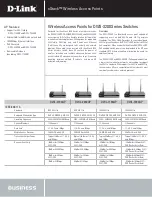
6
Chapter 3: Getting to Know the Wireless-G Access Point
The Front Panel
Wireless-G Access Point
Chapter 3: Getting to Know the Wireless-G Access Point
The Front Panel
The Access Point's LEDs, which indicate activity and status information, are located on the front panel.
(Cisco logo)
Orange/White. The Cisco logo is the Access Point’s SecureEasySetup button. It lights up when
the Access Point is powered on. The Cisco logo is orange when the SecureEasySetup feature
is not used, while the color white indicates that the SecureEasySetup feature is being used.
When the Access Point enters SecureEasySetup mode, the Cisco logo will turn white and start
flashing. Then the Access Point will generate its SSID (network name) and WPA-Personal (also
called WPA-PSK) key. If the Access Point successfully associates with a client using
SecureEasySetup, the Cisco logo will stop flashing and stay white. If the association is
unsuccessful, then the Cisco logo will stop flashing and stay orange.
To clear the SSID and WPA-Personal key, press and hold down the Cisco logo for ten seconds.
The Cisco logo will turn orange to indicate a successful reset.
Power
Red. The
Power
LED lights up when the Access Point is powered on.
Act
Green. The
Act
LED lights up when the Access Point is ready for wireless use. It flashes when
the Access Point is transmitting or receiving data wirelessly.
Link
Orange. The
Link
LED lights up when the Access Point is successfully connected to a device
through the Ethernet network port. The LED flashes when the Access Point is transmitting or
receiving data through the Ethernet network port.
Figure 3-1: Front Panel
NOTE:
SecureEasySetup is a feature that makes it
easy to set up your wireless network. If you have
SecureEasySetup devices, run the Setup Wizard on
the Access Point’s Setup Wizard CD-ROM. Then
follow the on-screen instructions.
















































